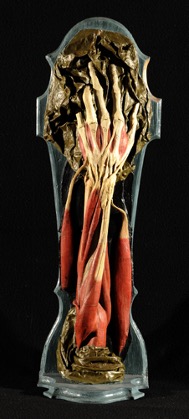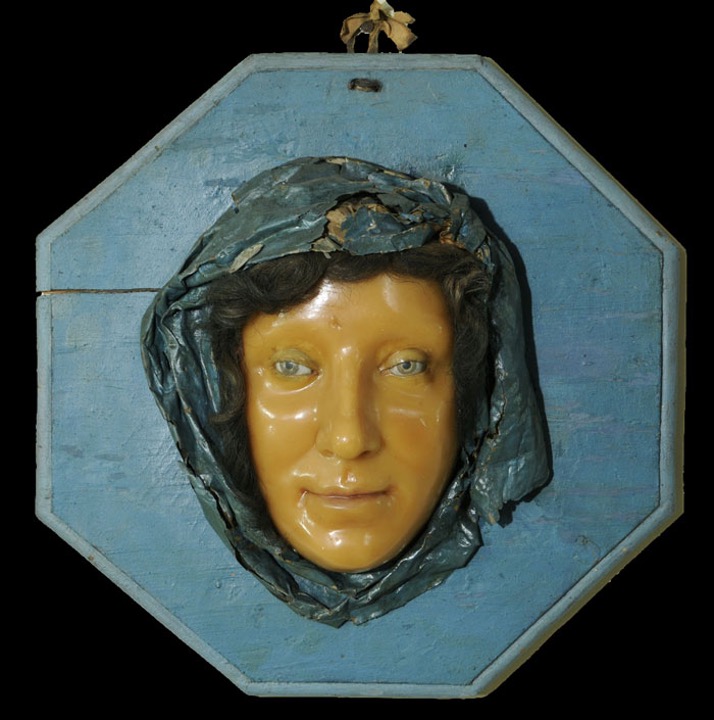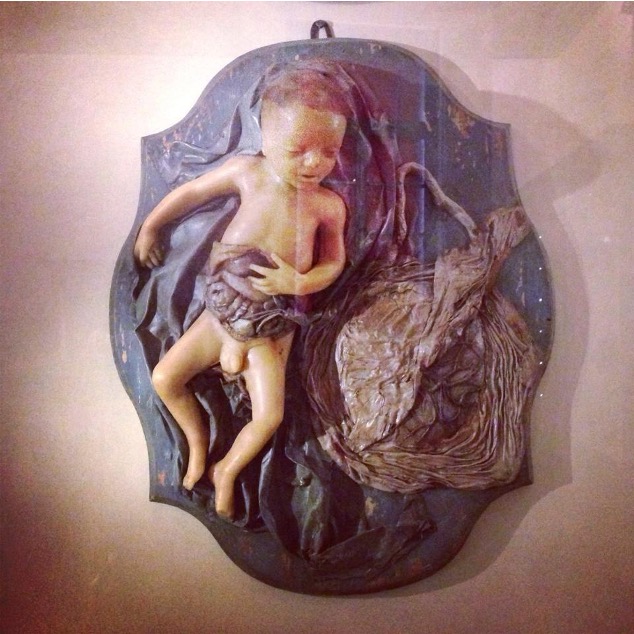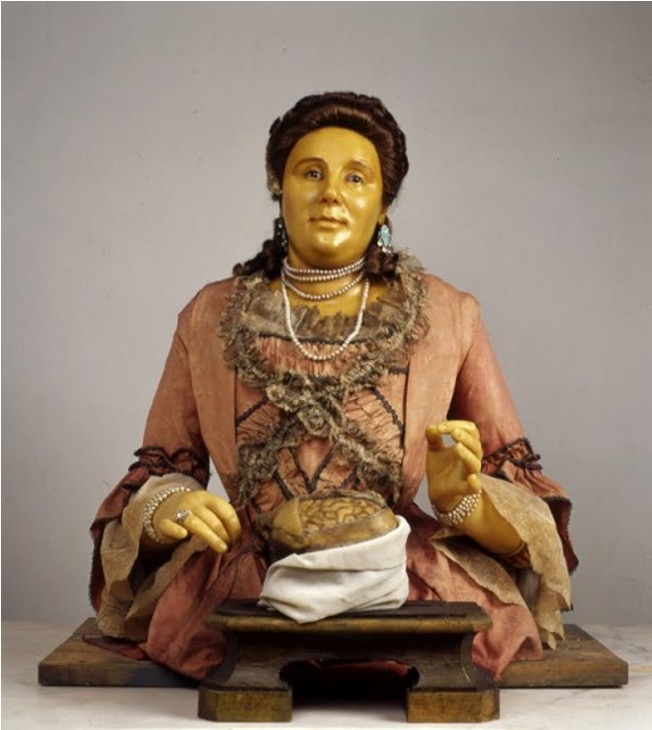Anna Morandi Manzolini
Active in: Italy, Russia, England
Alternate names: Anna Morandi
Biography
Born in Bologna on January 21, 1714, Anna Morandi Manzolini achieved international acclaim as an anatomical wax modeler and professor of anatomy. Little is known about her early life, but by the 1730s she was training in the studios of two prominent Bolognese painters: Giuseppe Pedretti (1694—1778) and Francesco Monti (1685—1768). It was around this time that she met the painter turned sculptor and anatomist Giovanni Manzolini (1702–1755), who she married in 1740. They would have eight children, although only two would live to adulthood. The couple established a studio and dissection space in their home in Ca San Petronio on Borgo della Paglia where they systematically disassembled cadavers and produced wax models.
By the mid-1740s, Manzolini and her husband had achieved enough success to gain patronage, including that of Giovanni Antonio Galli (1708–1782), a professor of surgery at the Università di Bologna, who commissioned twenty wax models of the female reproductive system to use in obstetrics lectures. Manzolini and her husband moved to a house known as the Casa del Seminario, near the Cathedral of San Pietro, in 1752.
In 1755, Giovanni Manzolini died suddenly and Manzolini was left financially responsible for herself and their two children. She wrote to Pope Benedict XIV (1675–1758) to ask for his assistance in finding a position in Bologna so that her family could stay in their native city and by December of that year, she was granted a wax modeling and teaching position at the Università di Bologna. In 1761, the Accademia delle Arti del Disegno in Florence awarded her with honorary membership. She was recognized throughout Europe for her accomplishments and invited to the court of Catherine II of Russia and to lecture to the British Royal Society in London. Despite these accomplishments, Manzolini continued to struggle financially and sold her entire oeuvre to the Bolognese senator Count Girolamo Ranuzzi in 1769. Manzolini died on July 9, 1774, and just two years later, Count Ranuzzi sold his collection of her work to what is now the Accademia delle Scienze dell'Istituto di Bologna. Those works are installed today in the Museo di Palazzo Poggi at the Università di Bologna.
Selected Works

Anna Morandi Manzolini, Muscles of the Forearm, ca. 1745–50. Wax, cloth, and wood. Museo di Palazzo Poggi, Bologna.
Circle
Student of
Giuseppe Pedretti (1694—1778)
Student of
Francesco Monti (1685—1768)
Wife of
Giovanni Manzolini (1702–1755)
Bibliography
Armaroli, Mino, ed. Le cere anatomiche bolognesi del Settecento. Bologna: Clueb, 1981.
Bianchi, Ilaria. “Femminea natura degli studi sopra i cadaveri. L’arte della scienza di Anna Morandi Manzolini.” Annuario della scuola di specializzazione in storia dell’artte dell’Universitàdi Bologna 3 (2002): 21–41.
Cavazza, Marta. “Dottrici e lettrici dell’Università di Bologna nel Settecento.” Annali di storia delle università italiane1 (1997): 109–26.
Dacome, Lucia. Malleable Anatomies, Models, Makers and Material Culture in 18th-century Italy. Oxford: Oxford University Press, 2017.
“Women, Wax, and Anatomy in the ‘Century of Things.’” Renaissance Studies: Spaces, Objects, and Identities in Early Modern Italian Medicine 21, no. 4 (September 2007): 522–50.
Logan, Gabriella Berti. “Women and the Practice and Teaching of Medicine in Bologna in the Eighteenth and Early Nineteenth Centuries.” Bulletin of the History of Medicine 77, no. 3 (2002): 506–35.
Messbarger, Rebecca. “Waxing Poetic: Anna Morandi Manzolini’s Anatomical Sculptures.” Configurations 9, no. 1 (2001): 65–97.
Messbarger, Rebecca, and Paula Findlen. The Contest for Knowledge: Debates over Women’s Learning in Eighteenth-Century Italy. Chicago: University of Chicago Press, 2007.
Ogilvie, Marilyn, and Joy Harvey. The Biographical Dictionary of Women in Science. New York: Routledge, 2000.
Ottani, Vittoria, and Gabriella Giuliani Piccari. “L’opera di Anna Morandi Manzolini nella ceroplastica anatomica Bolognese.” In Alma Mater Studiorum—La presenza femminile dal XVIII al XX secolo. Ricerche sul rapport donna/cultura universitaria nell’ Ateneo Bolognese, 81–103. Bologna: Università degli studi di Bologna, 1988.
Pancino, Claudia. “Donna e scienza.” In La memoria di lei. Storia delle donne, storia di genere, edited by G. Zarri, 89–104. Torino, 1996.
Peiffer, Jeanne. “L’âme, le cerveau et les mains: l’autoportrait d’Anna Morandi.” In Recontres entres artistes et mathématiciennes. Toutes un peu les autres, edited by T. Chotteau, et. al., 72–77. Paris, 2001.
Peiffer, Jeanne, and Véronique. Roca. “Corps moulés, corps façonnés. Autoportraits de femmes.” In Rencontres entre artistes et mathématiciennes: toutes un peu les autres, edited by T. Chotteau, 56–91. Paris: L'Harmattan, 2001.
Peiffer, Jeanne. “La recherche dans et hors se smurs.” Cahiers art et science, Special issue, Qu’est-ce qu’ils fabriquent? 7 (2002): 47–63.
San Juan, Rose Marie. “The Horror of Touch: Anna Morandi’s Wax Models of Hands.” Oxford Art Journal 34, no. 3 (2011): 433–47.
San Juan, Rose Marie. “Dying Not to See: Anna Morandi’s Wax Model of the Sense of Sight.” Oxford Art Journal 36, no. 1 (2013): 39–54.



